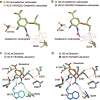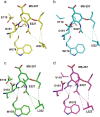Resistance to Mutant Group 2 Influenza Virus Neuraminidases of an Oseltamivir-Zanamivir Hybrid Inhibitor
- PMID: 27654293
- PMCID: PMC5110174
- DOI: 10.1128/JVI.01703-16
Resistance to Mutant Group 2 Influenza Virus Neuraminidases of an Oseltamivir-Zanamivir Hybrid Inhibitor
Abstract
Influenza virus neuraminidase (NA) drug resistance is one of the challenges to preparedness against epidemic and pandemic influenza virus infections. NA N1- and N2-containing influenza viruses are the primary cause of seasonal epidemics and past pandemics. The structural and functional basis underlying drug resistance of the influenza virus N1 NA is well characterized. Yet drug resistance of the N2 strain is not well understood. Here, we confirm that replacement of N2 E119 or I222 results in multidrug resistance, and when the replacements occur together, the sensitivity to NA inhibitors (NAI) is reduced severely. Using crystallographic studies, we showed that E119 replacement results in a loss of hydrogen bonding to oseltamivir and zanamivir, whereas I222 replacement results in a change in the hydrophobic environment that is critical for oseltamivir binding. Moreover, we found that MS-257, a zanamivir-oseltamivir hybrid inhibitor, is less susceptible to drug resistance. The binding mode of MS-257 shows that increased hydrogen bonding interactions between the inhibitor and NA active site anchor the inhibitor within the active site and allow adjustments in response to active-site modifications. Such stability is likely responsible for the observed reduced susceptibility to drug resistance. MS-257 serves as a next-generation anti-influenza virus drug candidate and serves also as a scaffold for further design of NAIs.
Importance: Oseltamivir and zanamivir are the two major antiviral drugs available for the treatment of influenza virus infections. However, multidrug-resistant viruses have emerged in clinical cases, which pose a challenge for the development of new drugs. N1 and N2 subtypes exist in the viruses which cause seasonal epidemics and past pandemics. Although N1 drug resistance is well characterized, the molecular mechanisms underlying N2 drug resistance are unknown. A previous report showed that an N2 E119V/I222L dual mutant conferred drug resistance to seasonal influenza virus. Here, we confirm that these substitutions result in multidrug resistance and dramatically reduced sensitivity to NAI. We further elucidate the molecular mechanism underlying N2 drug resistance by solving crystal structures of the N2 E119V and I222L mutants and the dual mutant. Most importantly, we found that a novel oseltamivir-zanamivir hybrid inhibitor, MS-257, remains more effective against drug-resistant N2 and is a promising candidate as a next-generation anti-influenza virus drug.
Copyright © 2016, American Society for Microbiology. All Rights Reserved.
Figures





Similar articles
-
Impact on antiviral resistance of E119V, I222L and R292K substitutions in influenza A viruses bearing a group 2 neuraminidase (N2, N3, N6, N7 and N9).J Antimicrob Chemother. 2016 Nov;71(11):3036-3045. doi: 10.1093/jac/dkw275. Epub 2016 Jul 17. J Antimicrob Chemother. 2016. PMID: 27432605
-
Screening for Neuraminidase Inhibitor Resistance Markers among Avian Influenza Viruses of the N4, N5, N6, and N8 Neuraminidase Subtypes.J Virol. 2017 Dec 14;92(1):e01580-17. doi: 10.1128/JVI.01580-17. Print 2018 Jan 1. J Virol. 2017. PMID: 29046464 Free PMC article.
-
Impact of neuraminidase mutations conferring influenza resistance to neuraminidase inhibitors in the N1 and N2 genetic backgrounds.Antivir Ther. 2006;11(8):971-6. Antivir Ther. 2006. PMID: 17302366
-
[Role of neuraminidase inhibitors for the treatment of influenza A virus infections].Pathol Biol (Paris). 2010 Apr;58(2):e69-78. doi: 10.1016/j.patbio.2010.01.011. Epub 2010 Mar 19. Pathol Biol (Paris). 2010. PMID: 20303677 Review. French.
-
Influenza neuraminidase inhibitors: antiviral action and mechanisms of resistance.Influenza Other Respir Viruses. 2013 Jan;7 Suppl 1(Suppl 1):25-36. doi: 10.1111/irv.12047. Influenza Other Respir Viruses. 2013. PMID: 23279894 Free PMC article. Review.
Cited by
-
Pre-Treatment with Zirconia Nanoparticles Reduces Inflammation Induced by the Pathogenic H5N1 Influenza Virus.Int J Nanomedicine. 2020 Jan 30;15:661-674. doi: 10.2147/IJN.S221667. eCollection 2020. Int J Nanomedicine. 2020. PMID: 32099358 Free PMC article.
-
Melatonin alleviates lung injury in H1N1-infected mice by mast cell inactivation and cytokine storm suppression.PLoS Pathog. 2023 May 18;19(5):e1011406. doi: 10.1371/journal.ppat.1011406. eCollection 2023 May. PLoS Pathog. 2023. PMID: 37200384 Free PMC article.
-
Structural and inhibitor sensitivity analysis of influenza B-like viral neuraminidases derived from Asiatic toad and spiny eel.Proc Natl Acad Sci U S A. 2022 Oct 18;119(42):e2210724119. doi: 10.1073/pnas.2210724119. Epub 2022 Oct 3. Proc Natl Acad Sci U S A. 2022. PMID: 36191180 Free PMC article.
-
Structural basis for a human broadly neutralizing influenza A hemagglutinin stem-specific antibody including H17/18 subtypes.Nat Commun. 2022 Dec 9;13(1):7603. doi: 10.1038/s41467-022-35236-y. Nat Commun. 2022. PMID: 36494358 Free PMC article.
-
UiO-66 nanoparticles combat influenza A virus in mice by activating the RIG-I-like receptor signaling pathway.J Nanobiotechnology. 2024 Mar 9;22(1):99. doi: 10.1186/s12951-024-02358-y. J Nanobiotechnology. 2024. PMID: 38461229 Free PMC article.
References
-
- Deyde V, Garten R, Sheu T, Smith C, Myrick A, Barnes J, Xu X, Shaw M, Klimov A, Gubareva L. 2009. Genomic events underlying the changes in adamantane resistance among influenza A(H3N2) viruses during 2006–2008. Influenza Other Respir Viruses 3:297–314. doi:10.1111/j.1750-2659.2009.00103.x. - DOI - PMC - PubMed
MeSH terms
Substances
Grants and funding
LinkOut - more resources
Full Text Sources
Other Literature Sources
Miscellaneous

